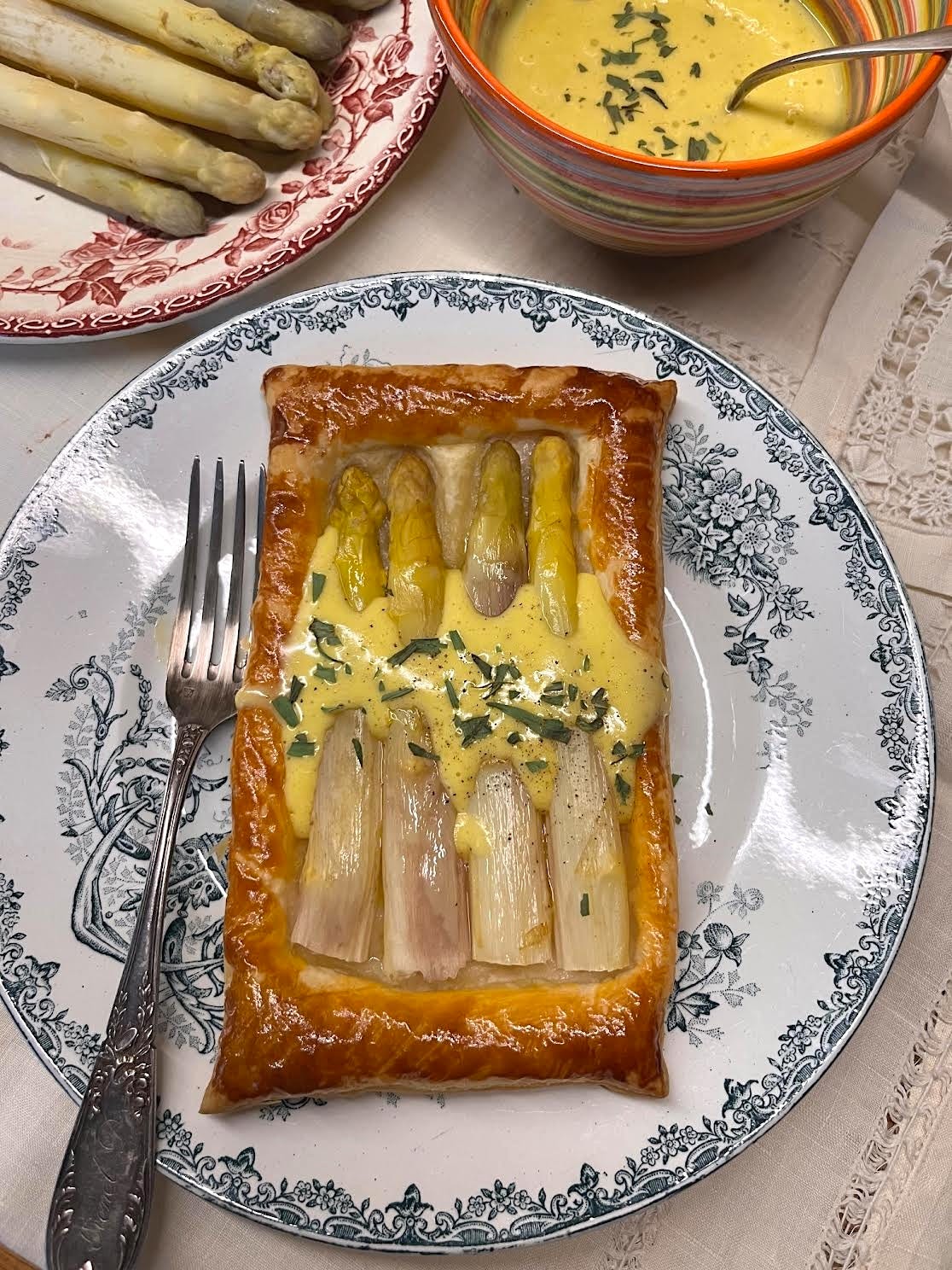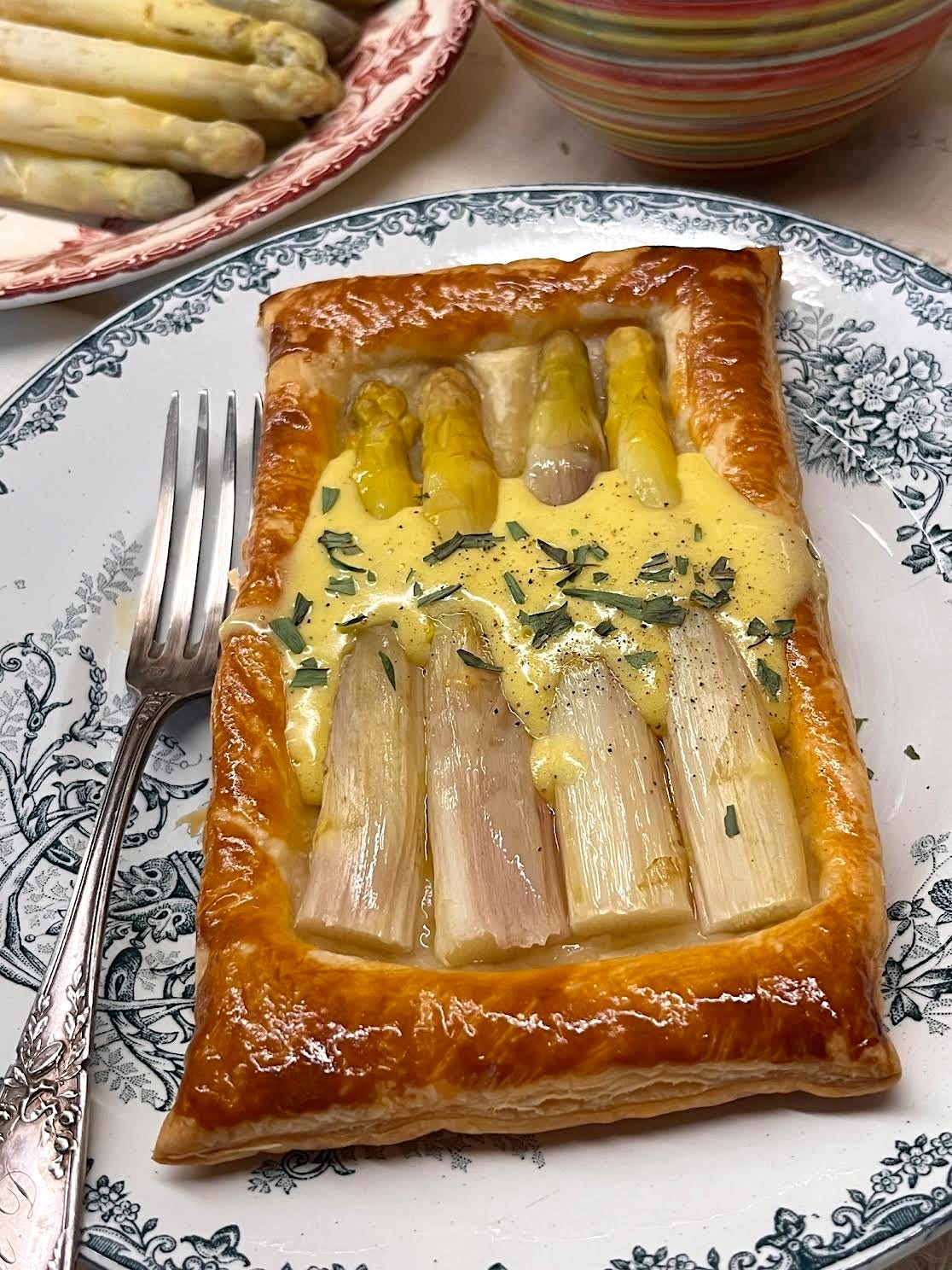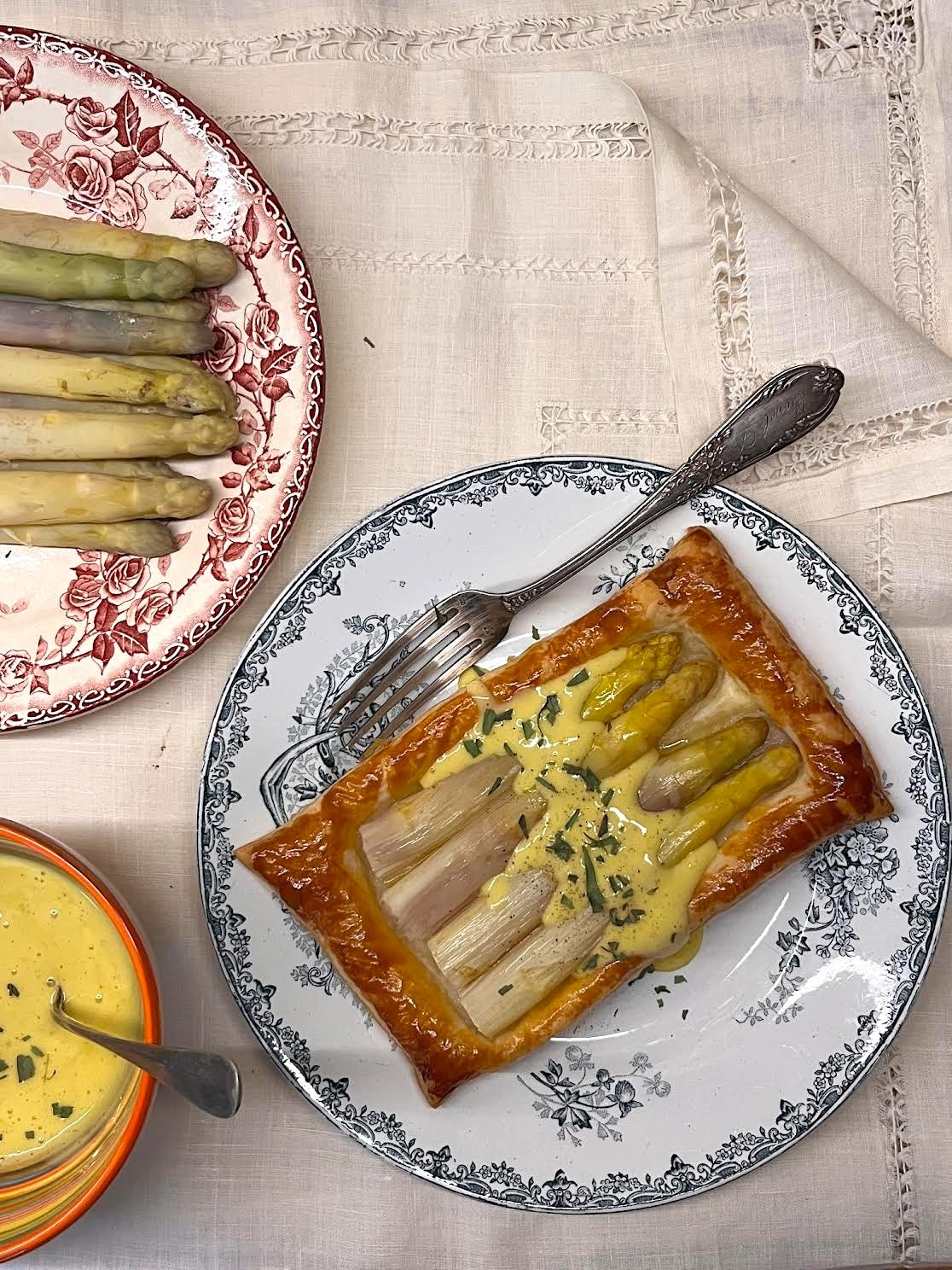Gourmandise is an act of our judgment by which we give preference to things that are pleasing to the taste over those that do not have this quality. - Brillat-Savarin
A friend recently sent me the link to a short cooking video which, frankly, made my head explode. The recipe? French onion matzo ball soup.
It wasn’t the fact that the woman put matzo balls in a bowl of French onion soup; I grew up celebrating Passover and fully appreciate the creativity it takes to get through eight days without bread, cake, flour, rice or grains. I have no issue with adapting non-traditional dishes to fit the holiday. What upset me was her take on French onion soup. And calling it “French onion soup”.
When I was researching French onion soup for one of my early Substack posts, I began with Julia Child’s Mastering the Art of French Cooking. I then moved on to online recipes from popular food blogs, newspaper columns, and culinary magazines—mostly American ones, since that’s my primary audience. I’m not sure I was surprised by what I found: how far these versions had drifted from the soup the French actually make in their homes, from the version that has existed for centuries.
The French onion matzo ball soup in the video was overwhelming—onions caramelized to a deep brown with added sugar, balsamic vinegar, fresh herbs, beef stock, and wine. Julia Child, trained in a Parisian cooking school, adds wine, Cognac, and vermouth along with a beef stock base to her version. Across the internet, recipes labeled “classic,” “authentic,” or “traditional” were anything but. They featured beef stock, yes, but also wine, sherry, balsamic vinegar, fresh herbs like thyme and parsley, bay leaves, sugar, dried chiles, hard cider, even porcini mushrooms. Many of these dishes sound delicious, but they are neither classic, authentic, nor traditional. They, in my own experience, and after extensive research, reflect cooking school or restaurant interpretations of a simple home classic.
Each was overloaded with a mix of intense flavors, that, combined, resulted in a dish that must be a chaotic taste experience.

When I published my own French family’s recipe for French onion soup - the broth traditional in its simplicity, only onions, salt, pepper, and water - and later the recipe for aïgo boulido, the delicate garlic soup from the Provençale region of France, followed by a classic leek and potato soup, I noticed something interesting in the feedback: many readers were surprised that something so simple, so plain and unadorned, could be so satisfying. Honestly, I was surprised, too.
And it got me thinking: have our taste buds changed? Have we, collectively, lost the ability to discern and appreciate subtlety in food? As a food writer and blogger focused on French culinary history, I’ve spent years following cooking trends, especially in the U.S. What I’ve observed is a growing tendency to overload recipes—soups, sauces, stews, cakes, puddings—not only with layer upon layer of flavor, but also with a kind of visual excess, as well. It’s become a combat of the senses. And while these dishes can be wildly delicious—or just plain fun—are we training our palates to only recognize bold, in-your-face flavors?
Have we become desensitized to the delicacy and often subtle qualities of simple dishes, of single ingredients? Must onions be caramelized? Must soups be enriched with meats broths? Do casseroles have to be blanketed under layers of cheese? I grew up on tuna noodle casserole, the two cooked in canned mushroom soup, the whole topped with crushed potato chips, so I definitely get the appeal.
To be perfectly honest, my first mouthfuls of each of those 3 soups revealed almost nothing; I struggled to taste anything. But I persisted, and with each spoonful of soup, the more the flavor emerged. By the end, I found myself thinking that each one might be the best thing I’d ever eaten.
I'm a food historian—or at least I like to think of myself as one; I study French culinary history. While discussing this conundrum (for a conundrum it surely is) with a couple of friends, it suddenly occurred to me that what we might be experiencing is simply a cultural cycle.
The evolution of French cuisine mirrors much of our changing relationship with flavor. In the medieval and Renaissance periods, French cooking was a tapestry of bold, complex flavors—rich stews and sauces laden with exotic spices, fruits paired with meats, fowl, and fish, and sweet and sour combinations. They adored acidic elements in their cooking, adding wine, verjus, or vinegar to many dishes, then balanced with the sweetness of honey and dried fruits. Later, the Italians added a multitude of aromatic herbs to the mix. While it was long believed that this robust combination of flavors was meant to cover up the horrid taste of bad meat, that theory has long been debunked; it was simply the popular taste of the time.
The greatest dishes are very simple. - Auguste Escoffier
But as French cuisine progressed, it began to simplify. In the early 19th century, Marie-Antoine Carême, regarded as the key figure in shaping modern French cuisine, rejected what he thought of as Italian influences in cooking, highly spiced or laden with herbs. He brought a level of elegance and simplicity to haute cuisine, focusing on technique and refinement - and single ingredients - opulence only in the serving, bringing the science and presentation of pastry to cooking. His successor, Auguste Escoffier, streamlined French cooking even further, establishing the modern foundations of French gastronomy with classic dishes that emphasized balance and flavor precision. Fast forward to the mid-20th century, and Nouvelle Cuisine emerged, rejecting heavy sauces and rich, over-the-top dishes in favor of lighter, more natural flavors that highlighted fresh ingredients. Each shift, from complexity to simplicity, reflected changing tastes and a continual search for a deeper appreciation of the food, to taste the ingredients for what they are.
In some ways, our current obsession with intensely flavored food isn’t entirely new. It reminds me of the culinary trends of the medieval era. Maybe we’re just coming full circle. Today’s obsession with big, bold flavors - recipes that pile on umami, sweetness, heat, and tang in a single bite - or shock with an excess of indulgent ingredients - might be a natural progression, a reaction to years of subtle elegance, or even to post-war restraint and moderation. Has extravagance once again replaced simplicity?
Or could it possibly be our finally embracing a cuisine that had always been reserved for the wealthy, the noble, the privileged? Peasant cuisine, “peasant” being an all-encompassing term for everyone who wasn’t wealthy, noble, privileged, and eventually bourgeois, was always relatively simple, those exotic, often expensive, lavish ingredients not being within their (our) reach. Nor did those without cooks or chefs in well-appointed kitchens have the time to create such extravagant dishes and pastries. So maybe, just maybe, we are coming full circle and allowing ourselves the luxury, the excess, even, at times, the absurdity of over-the-top cooking that was once so popular in a long-ago era, among a certain class.
This is something I’ve been thinking about for years—it both fascinates and drives me a little crazy. I’d really love to know what you think. Please share your thoughts in the comments—I genuinely want to hear your perspective.
I let Carême inspire me for this recipe, wanting to offer something that focused completely on the ingredients. I was intrigued by his Buisson d’Asperges en Croustade - Asparagus Bush in a Crust - in his 1828 Le Cuisinier Parisien.
This is a complicated, elegant pyramid-like structure crafted from asparagus tips, each spear meticulously arranged to form a lush, vertical bouquet, an edible bush. The asparagus tips are set in a puff pastry shell. This stunningly impressive arrangement is so simple, so delicate in its flavors: asparagus tips boil just until tender, the pastry pre-baked until crisp. No other ingredients are used in the dish. Carême serves this with a simple mayonnaise, which, when I made it, came out more like a light but thick, creamy vinaigrette. I, as Carême suggested, used a tarragon vinegar and no other flavorings except the salt and pepper seasoning of his own recipe. You could add some Dijon-style mustard to the “mayonnaise” - he actually adds a little aspic jelly along with the vinegar. A mustardy vinaigrette is such a very French accompaniment to freshly steam asparagus.
White Asparagus Croustade with Mayonnaise
Sauce Magnonnaise Blanche de Carême *
Asparagus, white or green
Puff pastry
2 egg yolks
Salt and freshly ground black pepper
Tarragon vinegar - Champagne or white wine vinegar would also be good
Olive oil *(see note)
Note: Carême used l’huile d’Aix, an olive oil from Aix-en-Provence; it’s described as a fruity, green oil with the aroma of fresh herbs and greens, green apple and almonds. I used an Italian olive oil, rather strongly flavored. My husband thought it was much too green, but in the end he loved the delicate sauce, a cross between a light vinaigrette and a mayonnaise.
Carême spelled mayonnaise magnonnaise… but that’s for a later post.
No quantities, really. Barely a recipe. I used store-bought, all-butter puff pastry and cut out rectangles that could each hold 4 short stalks of asparagus each, leaving about a 1-inch (2-cm) edge all around. I placed them on a parchment-lined baking sheet.
I gently boiled the 4- to 5-inch long (10-12 cm) asparagus tips, the tender part, until fork tender but not so cooked they fell apart. I drained them on paper towels and let them cool until I could handle them.
I preheated the oven to 350°F (180°C).
Once I lined up the tips/stalks in the center of the pastry rectangles, I marked the borders lightly with the point of a knife and lightly brushed the edges with beaten egg yolk. I drizzled a small amount of olive oil over the asparagus.
I baked them until the edges were risen and a deep golden brown and the pastries were golden underneath.
While the asparagus pastries were baking, I made the sauce, starting with a wooden spoon, as he used, and finishing with a hand-held electric whisk:
Whisk or whip the 2 egg yolks in a small bowl with salt and pepper - fairly generous pinches and you can add more later to taste - until creamy. Add ½ tablespoon of the vinegar and whisk or beat again. Add ½ tablespoon of the olive oil and whip. Add more of each, whisking after each addition, finally drizzling small amounts of only the olive oil, while whisking, until thick and creamy. I might’ve added, in total, the equivalent of 6 or 8 tablespoons of the olive oil. Taste and adjust seasoning.
Serve the croustades with the mayonnaise. You can dust with fresh chopped or dried tarragon and a grating of black pepper.
Thank you for reading and subscribing to my Substack Life’s a Feast. Please leave a comment, like and share the post…these are all simple ways you can support my writing and help build this very cool community. If you would like to further support my work and recipes, please consider becoming a paid subscriber. It’s truly appreciated.








I love your commentary/question: “ are we training our palates to only recognize bold, in-your-face flavors?”
I think there has been a movement over the last 10+ years that arose with the popularity/TV chef personality’s, to take a simple dish & “make it better” and in that we’ve lost the fine are of subtle flavors and the appreciation of them. Not every dish/bite needs to punch you in the face..
I was just having this conversation with my mom recently. I have two favorite dishes she makes — breaded slow roasted pork loin & meatloaf. Her recipes for both are simple and are delicious. Recently while cooking both dishes, she changed up the recipe. While good, not the expected flavor I love so much. I asked her why she felt the need to “change it up” and she said she had been watching show/saw how they were modifying a recipe “to make it better” —- I told my mom some recipes are perfect as is!
This is an intriguing question. Because I have always thought about how the snack industry flavors their offerings to specifically be addictively overpowering.
I have made your soups and have been sooooo tempted to add additional elements, but did not, and was pleasantly surprised to find how delicious the subtle flavors could be. 😍